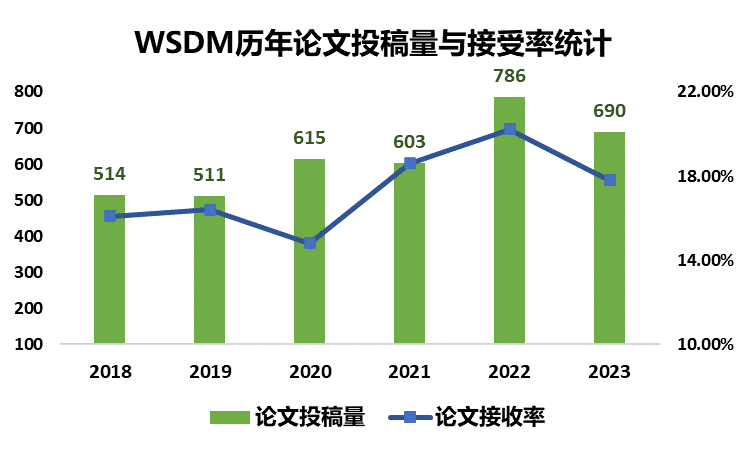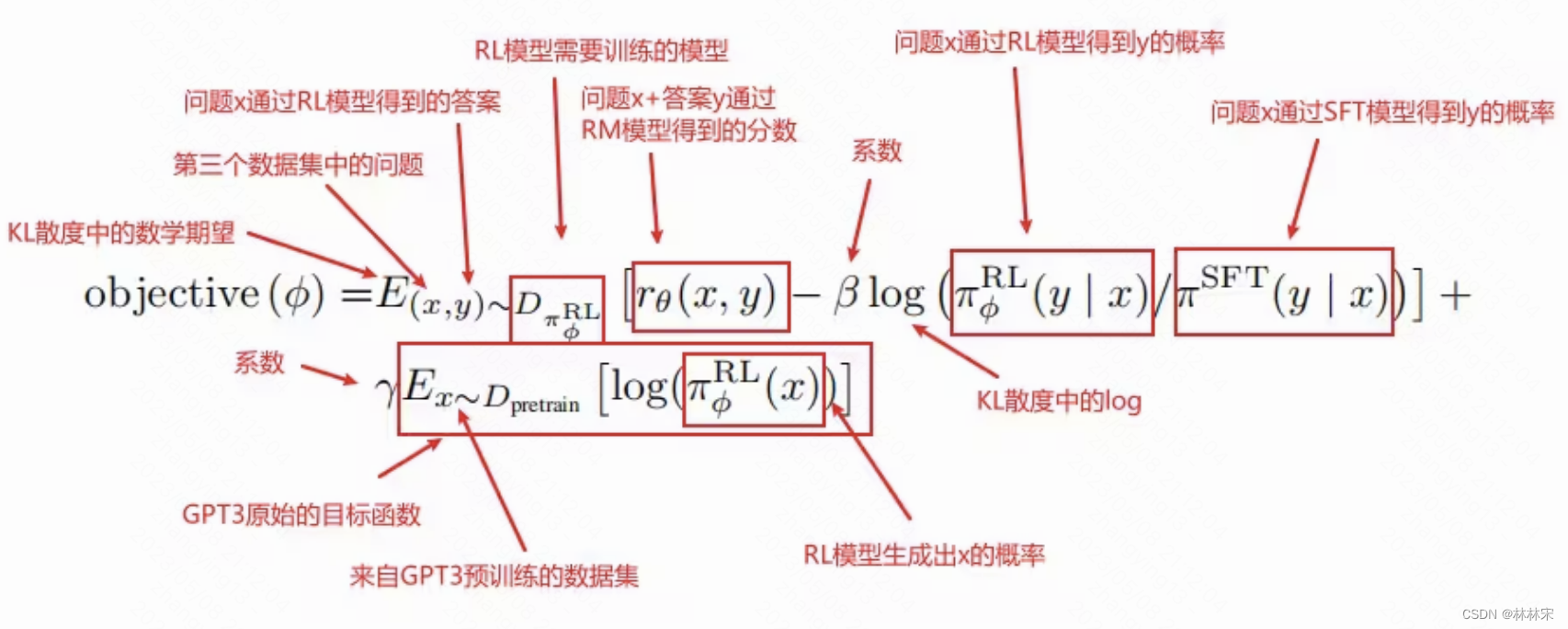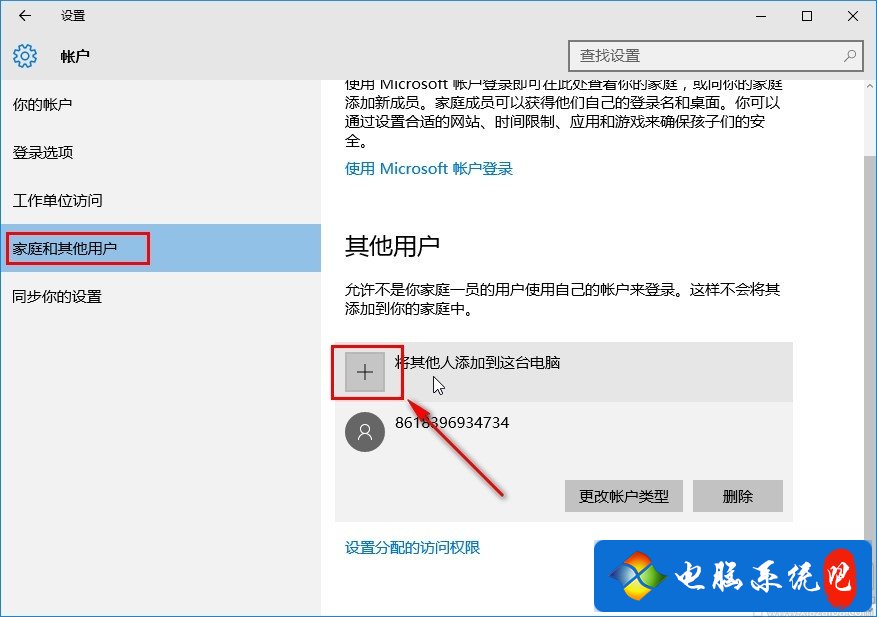嘿,记得给“机器学习与推荐算法”添加星标
第16届国际网络检索与数据挖掘会议WSDM将在2023年2月27日到3月3日于新加坡举行。今年此次会议共收到了690份有效投稿,最终录取篇数为123篇,录取率为17.8%。该会议历年的论文投稿量以及接收率可见下图。

作为主流的检索与数据挖掘会议,论文的话题主要侧重于搜索、推荐以及数据挖掘领域,因此该会议大部分接收论文的主题是围绕着信息检索与推荐系统来说的。若想了解去年以及前年WSDM相关信息可参考:
WSDM2021推荐系统论文集锦
WSDM2022推荐系统论文集锦
欢迎大家扫码进入微信群,一起交流学习鸭。

本文特意从123篇论文中筛选出与推荐系统强相关的42篇文章供大家欣赏,其中从主题上看大致包括了跨域推荐[1,4]、序列推荐[2,12,19,22]、多行为推荐[3,6]、基于排序建模的推荐[5]、多样性推荐[7,30]、可解释性推荐[8]、组推荐[9]、去偏推荐[10,31,36]、兴趣点推荐[11]、基于强化学习的推荐[13]、对话推荐[18,21]、路线推荐[20]、新闻推荐[23]、基于协同过滤的推荐[15,24,35]、因果推荐[26,28]、联邦遗忘学习推荐[27]、公平性推荐[29,40,41]、基于知识图的推荐[32]、基于解耦的推荐[7,11,35]、基于对比学习的推荐[33,,38]、基于知识蒸馏的推荐[39]等。
更多接收论文可前往官网查阅。
https://www.wsdm-conference.org/2023/program/accepted-papers
下文将列出相关的论文列表,包括论文标题、单位以及论文链接与摘要,供大家提前领略学术前沿趋势与牛人的最新想法。
1. Towards Universal Cross-Domain Recommendation
2. IDNP: Interest Dynamics Modeling using Generative Neural Processes for Sequential Recommendation
3. Learning to Distinguish Multi-User Coupling Behaviors for TV Recommendation
4. One for All, All for One: Learning and Transferring User Embeddings for Cross-Domain Recommendation
5. Slate-Aware Ranking for Recommendation
6. Knowledge Enhancement for Contrastive Multi-Behavior Recommendation
7. Disentangled Representation for Diversified Recommendations
8. Cognition-aware Knowledge Graph Reasoning for Explainable Recommendation
9. Self-Supervised Group Graph Collaborative Filtering for Group Recommendation
10. Calibrated Recommendations as a Maximum Flow Problem
11. DisenPOI: Disentangling Sequential and Geographical Influence for Point-of-Interest Recommendation
12. Multi-Intentions Oriented Contrastive Learning for Sequential Recommendation
13. Generative Slate Recommendation with Reinforcement Learning
14. MUSENET: Multi-Scenario Learning for Repeat-Aware Personalized Recommendation
15. A Personalized Neighborhood-based Model for Within-basket Recommendation in Grocery Shopping
16. SGCCL: Siamese Graph Contrastive Consensus Learning for Personalized Recommendation
17. Relation Preference oriented High-order Sampling for Recommendation
18. Variational Reasoning over Incomplete Knowledge Graphs for Conversational Recommendation
19. Exploiting Explicit and Implicit Item relationships for Session-based Recommendation
20. Range Restricted Route Recommendation Based on Spatial Keyword
21. Meta Policy Learning for Cold-Start Conversational Recommendation
22. Efficiently Leveraging Multi-level User Intent for Session-based Recommendation via Atten-Mixer Network
23. Improving News Recommendation with Channel-Wise Dynamic Representations and Contrastive User Modeling
24. Simplifying Graph-based Collaborative Filtering for Recommendation
25. AutoGen: An Automated Dynamic Model Generation Framework for Recommender System
26. A Causal View for Item-level Effect of Recommendation on User Preference
27. Federated Unlearning for On-Device Recommendation
28. Explicit Counterfactual Data Augmentation for Recommendation
29. Uncertainty Quantification for Fairness in Two-Stage Recommender Systems
30. DGRec: Graph Neural Network for Recommendation with Diversified Embedding Generation
31. Unbiased Knowledge Distillation for Recommendation
32. VRKG4Rec: Virtual Relational Knowledge Graph for Recommendation
33. Knowledge-Adaptive Contrastive Learning for Recommendation
34. Heterogeneous Graph Contrastive Learning for Recommendation
35. Disentangled Negative Sampling for Collaborative Filtering
36. Separating Examination and Trust Bias from Click Predictions for Unbiased Relevance Ranking
37. A Bird’s-eye View of Reranking: from List Level to Page Level
38. CL4CTR: A Contrastive Learning Framework for CTR Prediction
39. Directed Acyclic Graph Factorization Machines for CTR Prediction via Knowledge Distillation
40. Pairwise Fairness in Ranking as a Dissatisfaction Measure
41. Marginal-Certainty-aware Fair Ranking Algorithm
42. An F-shape Click Model for Information Retrieval on Multi-block Mobile Pages
1. Towards Universal Cross-Domain Recommendation
Jiangxia Cao (Institute of Information Engineering, Chinese Academy of Sciences)*; Shaoshuai Li (Ant Group); Bowen Yu (Alibaba, DAMO Academy); xiaobo guo (antgroup); Tingwen Liu (Institute of Information Engineering, CAS); Bin Wang (Xiaomi AI Lab)
2. IDNP: Interest Dynamics Modeling using Generative Neural Processes for Sequential Recommendation
Jing Du (University of New South Wales)*; Zesheng Ye (University of New South Wales, Sydney); Lina Yao (University of New South Wales); bin guo (Northwestern Polytechnical University); zhiwen yu (Northwestern Polytechnical University)
https://arxiv.org/abs/2208.04600
Recent sequential recommendation models rely increasingly on consecutive short-term user-item interaction sequences to model user interests. These approaches have, however, raised concerns about both short- and long-term interests. (1) short-term: interaction sequences may not result from a monolithic interest, but rather from several intertwined interests, even within a short period of time, resulting in their failures to model skip behaviors; (2) long-term: interaction sequences are primarily observed sparsely at discrete intervals, other than consecutively over the long run. This renders difficulty in inferring long-term interests, since only discrete interest representations can be derived, without taking into account interest dynamics across sequences. In this study, we address these concerns by learning (1) multi-scale representations of short-term interests; and (2) dynamics-aware representations of long-term interests. To this end, we present an Interest Dynamics modeling framework using generative Neural Processes, coined IDNP, to model user interests from a functional perspective. IDNP learns a global interest function family to define each user's long-term interest as a function instantiation, manifesting interest dynamics through function continuity. Specifically, IDNP first encodes each user's short-term interactions into multi-scale representations, which are then summarized as user context. By combining latent global interest with user context, IDNP then reconstructs long-term user interest functions and predicts interactions at upcoming query timestep. Moreover, IDNP can model such interest functions even when interaction sequences are limited and non-consecutive. Extensive experiments on four real-world datasets demonstrate that our model outperforms state-of-the-arts on various evaluation metrics.
3. Learning to Distinguish Multi-User Coupling Behaviors for TV Recommendation
Jiarui Qin ( Shanghai Jiao Tong University)*; jiachen J zhu (Shanghai Jiaotong University); yankai liu (China Mobile); Junchao Gao (China Mobile); Jianjie Ying (China Mobile); Chaoxiong Liu (Digital Brain Lab); Ding Wang (China Mobile); Junlan Feng (China Mobile Research); Chao Deng (China Mobile Research Institute); Xiaozheng Wang (China Mobile); Jian Jiang (China Mobile); Cong Liu (China Mobile); Yong Yu (Shanghai Jiao Tong University); Haitao Zeng (China Mobile Research Institute); Weinan Zhang (Shanghai Jiao Tong University)
4. One for All, All for One: Learning and Transferring User Embeddings for Cross-Domain Recommendation
Chenglin Li (University of Alberta)*; Yuanzhen Xie (Tencent); Chenyun YU (SUN YAT-SEN University); Bo Hu (tencent); Zang Li (Tencent); Guoqiang Shu (Tencent); Xiaohu Qie (Tencent); Di Niu (University of Alberta)
5. Slate-Aware Ranking for Recommendation
Yi Ren (Tencent)*; Han Xiao (Tencent); Xu Zhao (Tencent); shenzheng zhang (tencent); Yan Zhang (Tencent)
6. Knowledge Enhancement for Contrastive Multi-Behavior Recommendation
HongRui Xuan (Nanjing University of Aeronautics and Astronautics); Yi Liu (Nanjing University of Aeronautics and Astronautics); Bohan Li (Nanjing University of Aeronautics and Astronautics)*; Hongzhi Yin (The University of Queensland)
7. Disentangled Representation for Diversified Recommendations
Xiaoying Zhang (ByteDance Inc.)*; Hongning Wang (University of Virginia); Hang Li (Toutiao Inc)
8. Cognition-aware Knowledge Graph Reasoning for Explainable Recommendation
Qingyu Bing (Renmin University of China); Qiannan Zhu (Gaoling School of Artificial Intelligence, Renmin University of China)*; Zhicheng Dou (Renmin University of China)
9. Self-Supervised Group Graph Collaborative Filtering for Group Recommendation
Kang Li (Sun Yat-sen University); Chang-Dong Wang (Sun Yat-sen University)*; Jian-Huang Lai (Sun Yat-sen University); Huaqiang Yuan (Dongguan University of Technology)
10. Calibrated Recommendations as a Maximum Flow Problem
Himan Abdollahpouri (Spotify)*; Zahra Nazari (Spotify); Alex Gain (Spotify); Clay Gibson (Spotify); Maria Dimakopoulou (Spotify); Jesse Anderton (Spotify); Benjamin Carterette (Spotify); Mounia Lalmas (Spotify); Tony Jebara (Spotify)
11. DisenPOI: Disentangling Sequential and Geographical Influence for Point-of-Interest Recommendation
Yifang Qin (Peking University)*; Yifan Wang (Peking University); Fang Sun (School of EECS, Peking University); Wei Ju (Peking University); xuyang hou (meituan); zhe wang (sankuai); JIA CHENG (MEITUAN); Jun Lei (Meituan); Ming Zhang (Peking University)
https://arxiv.org/abs/2210.16591
Point-of-Interest (POI) recommendation plays a vital role in various location-aware services. It has been observed that POI recommendation is driven by both sequential and geographical influences. However, since there is no annotated label of the dominant influence during recommendation, existing methods tend to entangle these two influences, which may lead to sub-optimal recommendation performance and poor interpretability. In this paper, we address the above challenge by proposing DisenPOI, a novel Disentangled dual-graph framework for POI recommendation, which jointly utilizes sequential and geographical relationships on two separate graphs and disentangles the two influences with self-supervision. The key novelty of our model compared with existing approaches is to extract disentangled representations of both sequential and geographical influences with contrastive learning. To be specific, we construct a geographical graph and a sequential graph based on the check-in sequence of a user. We tailor their propagation schemes to become sequence-/geo-aware to better capture the corresponding influences. Preference proxies are extracted from check-in sequence as pseudo labels for the two influences, which supervise the disentanglement via a contrastive loss. Extensive experiments on three datasets demonstrate the superiority of the proposed model.
12. Multi-Intentions Oriented Contrastive Learning for Sequential Recommendation
Xuewei Li (Tianjin University); Aitong Sun ( Tianjin University); Mankun Zhao (Tianjin University); Jian Yu (Tianjin University); Kun Zhu (Tianjin University); Di Jin (Tianjin University); Mei Yu (Tianjin University)*; Ruiguo Yu (Tianjin University)
13. Generative Slate Recommendation with Reinforcement Learning
Romain Deffayet (Naver Labs Europe)*; Thibaut Thonet (Naver Labs Europe); Jean-Michel Renders (NAVER LABS Europe); Maarten de Rijke (University of Amsterdam)
14. MUSENET: Multi-Scenario Learning for Repeat-Aware Personalized Recommendation
Senrong Xu (Nanjing University)*; Liangyue Li (Alibaba Group); Yuan Yao (Nanjing University); Zulong Chen (Alibaba); Han Wu (alibaba Group); Quan Lu (Alibaba Group); Hanghang Tong (University of Illinois at Urbana-Champaign)
15. A Personalized Neighborhood-based Model for Within-basket Recommendation in Grocery Shopping
Mozhdeh Ariannezhad (University of Amsterdam)*; Ming Li (University of Amsterdam); Sebastian Schelter (University of Amsterdam); Maarten de Rijke (University of Amsterdam)
16. SGCCL: Siamese Graph Contrastive Consensus Learning for Personalized Recommendation
Boyu Li (University of Technology Sydney)*; Ting Guo (University of Technology, Sydney); Xingquan Zhu (Florida Atlantic University); Qian Li (Curtin University); Yang Wang (UTS); Fang Chen (UTS)
17. Relation Preference oriented High-order Sampling for Recommendation
Mukun Chen (Wuhan University)*; Xiuwen Gong (The University of Sydney); YH Jin (Center for Evidence-Based and Translational Medicine, Wuhan University); Wenbin Hu (Wuhan University)
18. Variational Reasoning over Incomplete Knowledge Graphs for Conversational Recommendation
Xiaoyu Zhang (Shandong University)*; Xin Xin (Shandong University); Dongdong Li (Shandong University); Wenxuan Liu (Shandong University); Pengjie Ren (Shandong University); Zhumin Chen (Shandong University); Jun Ma (Shandong University); Zhaochun Ren (Shandong University)
19. Exploiting Explicit and Implicit Item relationships for Session-based Recommendation
Zihao Li (University of Technology Sydney)*; Xianzhi Wang (University of Technology Sydney); Chao Yang (University of Technology, Sydney); Lina Yao (University of New South Wales); Julian McAuley (UCSD); Guandong Xu (University of Technology Sydney, Australia)
20. Range Restricted Route Recommendation Based on Spatial Keyword
Hongwei Tang (Soochow University); Detian Zhang (Soochow University)*
21. Meta Policy Learning for Cold-Start Conversational Recommendation
Zhendong Chu (University of Virginia)*; Hongning Wang (University of Virginia); Xiao Yun (JD.com); Bo Long (JD.com); Lingfei Wu (JD.COM Silicon Valley Research Center)
https://arxiv.org/abs/2205.11788
Conversational recommender systems (CRS) explicitly solicit users' preferences for improved recommendations on the fly. Most existing CRS solutions employ reinforcement learning methods to train a single policy for a population of users. However, for users new to the system, such a global policy becomes ineffective to produce conversational recommendations, i.e., the cold-start challenge.
In this paper, we study CRS policy learning for cold-start users via meta reinforcement learning. We propose to learn a meta policy and adapt it to new users with only a few trials of conversational recommendations. To facilitate policy adaptation, we design three synergetic components. First is a meta-exploration policy dedicated to identify user preferences via exploratory conversations. Second is a Transformer-based state encoder to model a user's both positive and negative feedback during the conversation. And third is an adaptive item recommender based on the embedded states. Extensive experiments on three datasets demonstrate the advantage of our solution in serving new users, compared with a rich set of state-of-the-art CRS solutions.
22. Efficiently Leveraging Multi-level User Intent for Session-based Recommendation via Atten-Mixer Network
Peiyan Zhang (Hong Kong University of Science and Technology)*; Jiayan Guo (Peking University); Chaozhuo Li (Microsoft Research Asia); Yueqi Xie (The Hong Kong University of Science and Technology); Jae Boum KIM (Hong Kong University of Science and Technology); Yan Zhang (Peking University); Xing Xie (Microsoft Research Asia); Haohan Wang (University of Illinois Urbana-Champaign); Sunghun Kim (Hong Kong University of Science and Technology)
https://arxiv.org/abs/2206.12781
Session-based recommendation (SBR) aims to predict the user next action based on short and dynamic sessions. Recently, there has been an increasing interest in utilizing various elaborately designed graph neural networks (GNNs) to capture the pair-wise relationships among items, seemingly suggesting the design of more complicated models is the panacea for improving the empirical performance. However, these models achieve relatively marginal improvements with exponential growth in model complexity. In this paper, we dissect the classical GNN-based SBR models and empirically find that some sophisticated GNN propagations are redundant, given the readout module plays a significant role in GNN-based models. Based on this observation, we intuitively propose to remove the GNN propagation part, while the readout module will take on more responsibility in the model reasoning process. To this end, we propose the Multi-Level Attention Mixture Network (Atten-Mixer), which leverages both concept-view and instance-view readouts to achieve multi-level reasoning over item transitions. As simply enumerating all possible high-level concepts is infeasible for large real-world recommender systems, we further incorporate SBR-related inductive biases, i.e., local invariance and inherent priority to prune the search space. Experiments on three benchmarks demonstrate the effectiveness and efficiency of our proposal.
23. Improving News Recommendation with Channel-Wise Dynamic Representations and Contrastive User Modeling
Jingkun Wang (Peking University)*; Yongtao Jiang (Peking University); Haochen Li (Peking University); Wen Zhao (Peking University)
24. Simplifying Graph-based Collaborative Filtering for Recommendation
Li HE (University of Technology Sydney)*; Xianzhi Wang (University of Technology Sydney); Dingxian Wang (Ebay); zou haoyuan (Meta); Hongzhi Yin (The University of Queensland); Guandong Xu (University of Technology Sydney, Australia)
25. AutoGen: An Automated Dynamic Model Generation Framework for Recommender System
Chenxu Zhu (Shanghai Jiao Tong University)*; Bo Chen (Huawei Noah’s Ark Lab); Huifeng Guo (Huawei Noah's Ark Lab); Hang Xu (Huawei Noah's Ark Lab); Xiangyang Li (Peking University); Xiangyu Zhao (City University of Hong Kong); Weinan Zhang (Shanghai Jiao Tong University); Yong Yu (Shanghai Jiao Tong University); Ruiming Tang (Huawei Noah's Ark Lab)
26. A Causal View for Item-level Effect of Recommendation on User Preference
Wei Cai (Zhejiang University (ZJU))*; Fuli Feng (University of Science and Technology of China); Qifan Wang (Meta AI); Tian Yang (Chinese University of Hong Kong); Zhenguang Liu (Zhejiang University); Congfu Xu (Zhejiang University)
27. Federated Unlearning for On-Device Recommendation
Wei Yuan (The University of Queensland)*; Hongzhi Yin (The University of Queensland); Fangzhao Wu (MSRA); shijie zhang (Tencent); Tieke He (State Key Laboratory for Novel Software Technology, Nanjing University); Hao Wang (Alibaba Cloud, Alibaba Group)
https://arxiv.org/pdf/2210.10958
The increasing data privacy concerns in recommendation systems have made federated recommendations (FedRecs) attract more and more attention. Existing FedRecs mainly focus on how to effectively and securely learn personal interests and preferences from their on-device interaction data. Still, none of them considers how to efficiently erase a user's contribution to the federated training process. We argue that such a dual setting is necessary. First, from the privacy protection perspective, ''the right to be forgotten'' requires that users have the right to withdraw their data contributions. Without the reversible ability, FedRecs risk breaking data protection regulations. On the other hand, enabling a FedRec to forget specific users can improve its robustness and resistance to malicious clients' attacks. To support user unlearning in FedRecs, we propose an efficient unlearning method FRU (Federated Recommendation Unlearning), inspired by the log-based rollback mechanism of transactions in database management systems. It removes a user's contribution by rolling back and calibrating the historical parameter updates and then uses these updates to speed up federated recommender reconstruction. However, storing all historical parameter updates on resource-constrained personal devices is challenging and even infeasible. In light of this challenge, we propose a small-sized negative sampling method to reduce the number of item embedding updates and an importance-based update selection mechanism to store only important model updates. To evaluate the effectiveness of FRU, we propose an attack method to disturb FedRecs via a group of compromised users and use FRU to recover recommenders by eliminating these users' influence. Finally, we conduct experiments on two real-world recommendation datasets with two widely used FedRecs to show the efficiency and effectiveness of our proposed approaches.
28. Explicit Counterfactual Data Augmentation for Recommendation
Jianchao Ji (Rutgers University)*; Zelong Li (Rutgers University); Shuyuan Xu (Rutgers University); Max Xiong (Rutgers Preparatory School); Juntao Tan (Rutgers University); Yingqiang Ge (Rutgers University); Hao Wang (Rutgers University); Yongfeng Zhang (Rutgers University)
29. Uncertainty Quantification for Fairness in Two-Stage Recommender Systems
Lequn Wang (Cornell)*; Thorsten Joachims (Cornell)
30. DGRec: Graph Neural Network for Recommendation with Diversified Embedding Generation
Liangwei Yang (University of Illinois at Chicago)*; Shengjie Wang (University of Washington); Yunzhe Tao (ByteDance Inc.); Jiankai Sun (ByteDance Inc.); Xiaolong Liu (University of Illinois at Chicago); Philip S Yu (UIC); Taiqing Wang (ByteDance Ltd)
31. Unbiased Knowledge Distillation for Recommendation
Liangwei Yang (University of Illinois at Chicago)*; Shengjie Wang (University of Washington); Yunzhe Tao (ByteDance Inc.); Jiankai Sun (ByteDance Inc.); Xiaolong Liu (University of Illinois at Chicago); Philip S Yu (UIC); Taiqing Wang (ByteDance Ltd)
32. VRKG4Rec: Virtual Relational Knowledge Graph for Recommendation
Lingyun Lu (Huazhong University of Science and Technology)*; Bang Wang (Huazhong University of Science and Technology (HUST)); Zizhuo Zhang (Huazhong University of Science and Technology (HUST)); Shenghao Liu (Huazhong University of Science and Technology); Han Xu (Huazhong University of Science and Technology)
https://arxiv.org/abs/2204.01089
Incorporating knowledge graph as side information has become a new trend in recommendation systems. Recent studies regard items as entities of a knowledge graph and leverage graph neural networks to assist item encoding, yet by considering each relation type individually. However, relation types are often too many and sometimes one relation type involves too few entities. We argue that it is not efficient nor effective to use every relation type for item encoding. In this paper, we propose a VRKG4Rec model (Virtual Relational Knowledge Graphs for Recommendation), which explicitly distinguish the influence of different relations for item representation learning. We first construct virtual relational graphs (VRKGs) by an unsupervised learning scheme. We also design a local weighted smoothing (LWS) mechanism for encoding nodes, which iteratively updates a node embedding only depending on the embedding of its own and its neighbors, but involve no additional training parameters. We also employ the LWS mechanism on a user-item bipartite graph for user representation learning, which utilizes encodings of items with relational knowledge to help training representations of users. Experiment results on two public datasets validate that our VRKG4Rec model outperforms the state-of-the-art methods. The implementations are available at:
https://github.com/lulu0913/VRKG4Rec
33. Knowledge-Adaptive Contrastive Learning for Recommendation
Hao Wang (Alibaba group, Beijing University of Posts and Telecommunications)*; Yao Xu (Alibaba group); Cheng Yang (School of Computer Science, Beijing University of Posts and Telecommunications); Xin Li (Alibaba Group); Chuan Shi (Beijing University of Posts and Telecommunications); Ning Guo (Alibaba Group); Zhiyuan Liu (Tsinghua University)
https://arxiv.org/abs/2204.01089
34. Heterogeneous Graph Contrastive Learning for Recommendation
Mengru Chen (South China University of Technology)*; Chao Huang (University of Hong Kong); Lianghao Xia (University of Hong Kong); Yong Xu (South China University of Technology); RongHua Luo (South China University of Technology); Wei Wei (University of Hong Kong)
35. Disentangled Negative Sampling for Collaborative Filtering
Riwei Lai (Harbin Engineering University); CHEN Li (Hong Kong Baptist University, Hong Kong); Yuhan Zhao (Harbin Engineering University); Rui Chen (Harbin Engineering University)*; Qilong Han (Harbin Engineering University)
36. Separating Examination and Trust Bias from Click Predictions for Unbiased Relevance Ranking
Haiyuan Zhao (Renmin University of China); Jun Xu (Renmin University of China)*; Xiao Zhang (Renmin University of China ); Guohao Cai (Huawei Noah's Ark Lab); Zhenhua Dong (Huawei Noah's Ark Lab); Ji-Rong Wen (Renmin University of China)
37. A Bird’s-eye View of Reranking: from List Level to Page Level
Yunjia Xi (Shanghai Jiao Tong University); Jianghao Lin (Shanghai Jiao Tong University)*; Weiwen Liu (Huawei Noah's Ark Lab); Xinyi Dai (Shanghai Jiao Tong University); Weinan Zhang (Shanghai Jiao Tong University); Rui Zhang (ruizhang.info); Ruiming Tang (Huawei Noah's Ark Lab); Yong Yu (Shanghai Jiao Tong University)
38. CL4CTR: A Contrastive Learning Framework for CTR Prediction
Fangye Wang (Fudan University)*; Yingxu Wang (Fudan University); Dongsheng Li (Microsoft Research Asia); Hansu Gu (Amazon.com); Tun Lu (Fudan University); Peng Zhang (Fudan University); Ning Gu (Fudan University)
39. Directed Acyclic Graph Factorization Machines for CTR Prediction via Knowledge Distillation
Zhen Tian (Renmin University of China)*; Ting Bai (Beijing University of Posts and Telecommunications); Zhang Zibin (Tencent); xu zhiyuan (tencent); Kangyi Lin (Tencent); Ji-Rong Wen (Renmin University of China); Wayne Xin Zhao (Renmin University of China)
40. Pairwise Fairness in Ranking as a Dissatisfaction Measure
Alessandro Fabris (University of Padua)*; Gianmaria Silvello (University of Padova); Gian Susto (University of Padova); Asia J. Biega (Max Planck Institute for Security and Privacy)
https://arxiv.org/abs/2204.01089
41. Marginal-Certainty-aware Fair Ranking Algorithm
Tao Yang (University of Utah)*; Zhichao Xu (University of Utah); Zhenduo Wang (University of Utah); Anh Tran (University of Utah); Qingyao Ai (University of Utah)
42. An F-shape Click Model for Information Retrieval on Multi-block Mobile Pages
Lingyue Fu (Shanghai Jiao Tong University); Jianghao Lin (Shanghai Jiao Tong University)*; Weiwen Liu (Huawei Noah's Ark Lab); Ruiming Tang (Huawei Noah's Ark Lab); Weinan Zhang (Shanghai Jiao Tong University); Rui Zhang (ruizhang.info); Yong Yu (Shanghai Jiao Tong University)
https://arxiv.org/abs/2206.08604
To provide click simulation or relevance estimation based on users' implicit interaction feedback, click models have been much studied during recent years. Most click models focus on user behaviors towards a single list. However, with the development of user interface (UI) design, the layout of displayed items on a result page tends to be multi-block (i.e., multi-list) style instead of a single list, which requires different assumptions to model user behaviors more accurately. There exist click models for multi-block pages in desktop contexts, but they cannot be directly applied to mobile scenarios due to different interaction manners, result types and especially multi-block presentation styles. In particular, multi-block mobile pages can normally be decomposed into interleavings of basic vertical blocks and horizontal blocks, thus resulting in typically F-shape forms. To mitigate gaps between desktop and mobile contexts for multi-block pages, we conduct a user eye-tracking study, and identify users' sequential browsing, block skip and comparison patterns on F-shape pages. These findings lead to the design of a novel F-shape Click Model (FSCM), which serves as a general solution to multi-block mobile pages. Firstly, we construct a directed acyclic graph (DAG) for each page, where each item is regarded as a vertex and each edge indicates the user's possible examination flow. Secondly, we propose DAG-structured GRUs and a comparison module to model users' sequential (sequential browsing, block skip) and non-sequential (comparison) behaviors respectively. Finally, we combine GRU states and comparison patterns to perform user click predictions. Experiments on a large-scale real-world dataset validate the effectiveness of FSCM on user behavior predictions compared with baseline models.
欢迎干货投稿 \ 论文宣传 \ 合作交流
推荐阅读
基于自监督学习的多模态推荐算法
论文周报 | 推荐系统领域最新研究进展
腾讯联合西湖大学发布首个大规模多用途推荐系统数据集, 可评估超10种推荐任务
由于公众号试行乱序推送,您可能不再准时收到机器学习与推荐算法的推送。为了第一时间收到本号的干货内容, 请将本号设为星标,以及常点文末右下角的“在看”。
喜欢的话点个在看吧👇














![[简易的网站登录注册,注销退出操作]](https://img-blog.csdnimg.cn/5b9346d144ea4997b9d1cc984866b0a1.png?x-oss-process=image/watermark,type_ZHJvaWRzYW5zZmFsbGJhY2s,shadow_50,text_Q1NETiBA5bCP5pm6UkUw,size_17,color_FFFFFF,t_70,g_se,x_16)

